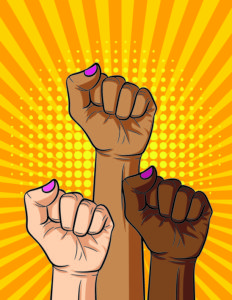
Two years into the Trump administration, it’s clear to all except the willfully blind that we are immersed in a racist, sexist culture that reduces every difference to harmful stereotypes.
Like living, breathing satire, he distills our most common and destructive cultural tendencies to their purest form—laying them bare for all to see.
Black people? Criminals.
Undocumented immigrants? Also criminals.
Women? Worth only as much as their beauty.
Transgender? Unnatural. Unworthy even to die for their country.
Liberal? Stupid snowflakes. (I still dig snowflake thing though. Frostbite, bitches.)
We can change the world. But we also need to change ourselves.
What is Unconscious Bias?
Bias is nothing more than the tendency to favor one thing over another, according to Overcoming Bias, Building Authentic Relationships Across Difference by Tiffany Jana and Matthew Freeman.
You probably favor certain colors, flavors, smells, or athletes, and that’s OK. Unless you’re in kindergarten, no one cares whether you prefer blue.
Humans are hardwired for bias. You won’t last long on the savannah if you can’t tell the difference between a harmless gazelle and an angry hippopotamus (one of the most dangerous animals in Africa, hippos are responsible for approximately 500 deaths annually).
The ability to make split-second decisions has helped us survive as a species. But bias is a problem when we prefer certain kinds of people. That’s why stereotypes are dangerous. When you believe them, they lead to bias.
Unfortunately, a lot of people aren’t aware of the preferences they hold or the stereotypes they believe.
How to Reduce Your Unconscious Bias
Unconscious beliefs can impact your behavior in subtle but insidious ways. For example, a teacher who consciously values equality may have lower expectations for black students, or see danger where there is none.
We’re all responsible for reducing our unconscious bias. The following strategies have been proven to reduce unconscious racial bias by making people aware of their discriminatory beliefs and behaviors, and their impact:
- Stereotype replacement. Use this 3-step process when you detect stereotypical responses within yourself or in your environment:
- Label the response or portrayal as stereotypical.
- Evaluate the situation to determine what happened and how it can be prevented in the future.
- Replace the stereotype with a non-stereotypical response or portrayal.
- Counter-stereotypic imaging. When you identify a stereotype, think of friends, acquaintances, or famous people who disprove it. For example, while watching a movie that depicts black people as criminal, think about positive examples of black people, such as Barack and Michelle Obama or Beyoncè.
- Individuation. Stereotypes are widely held beliefs about entire groups of people, such as fat people are stupid, lazy, and unattractive. To counteract this tendency, pay attention to individual characteristics. That will help you evaluate people as individuals not stereotypes.
- Perspective taking. When you detect a biased response in yourself or your environment, imagine what it would feel like to be viewed as stupid, lazy, unattractive, or oversexualized due to your race, ethnicity, gender, sexual orientation, and etc. This can help you develop empathy for members of stereotyped groups and assess the impact of stereotypes.
- Increasing opportunities for contact. To counteract bias, actively seek out opportunities to interact with people who are different. Try new classes, clubs, and events. Also consider diversifying your media. Look for movies, TV, news, YouTube channels, podcasts, and social media stars that portray stereotyped groups in a positive light.
